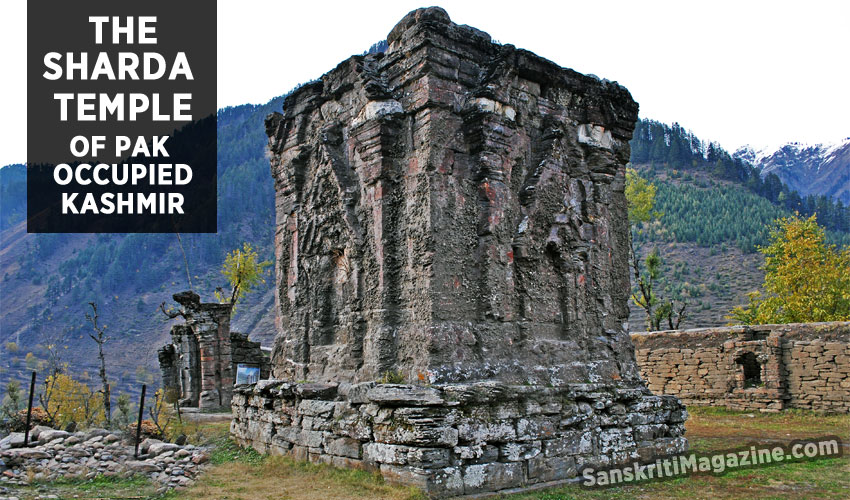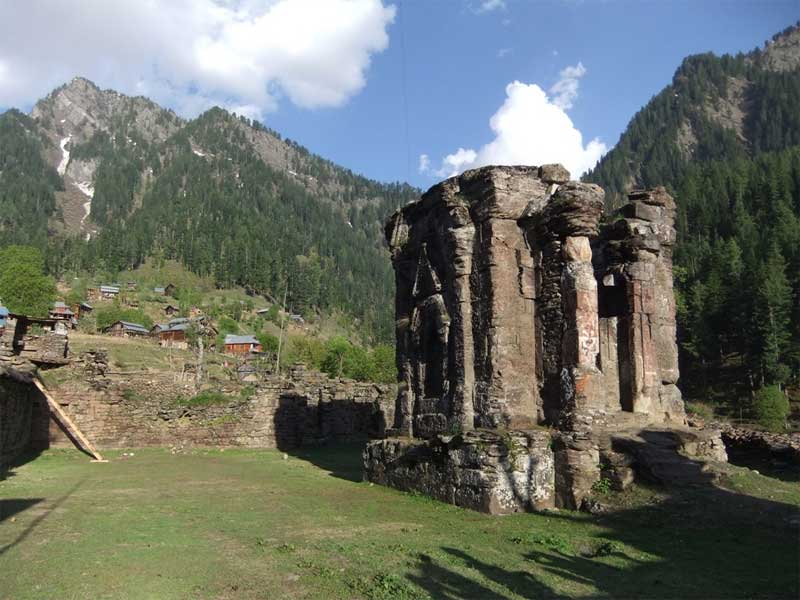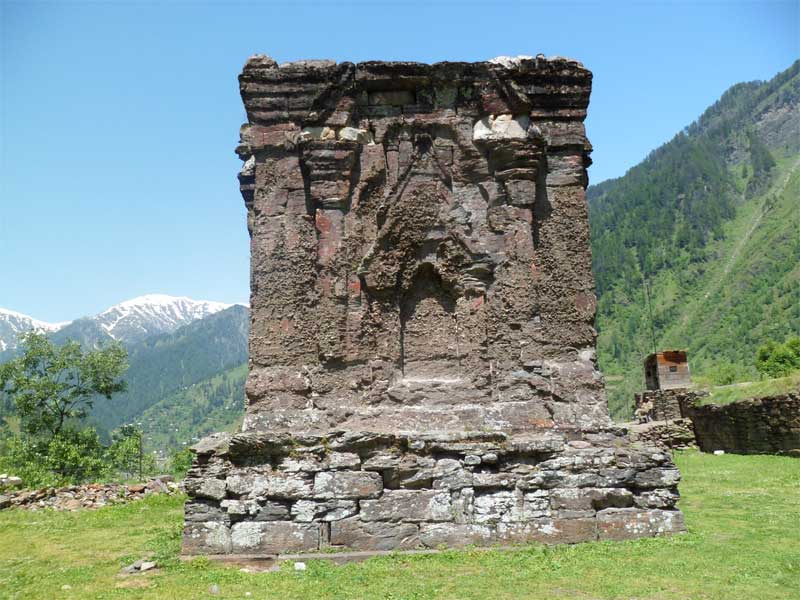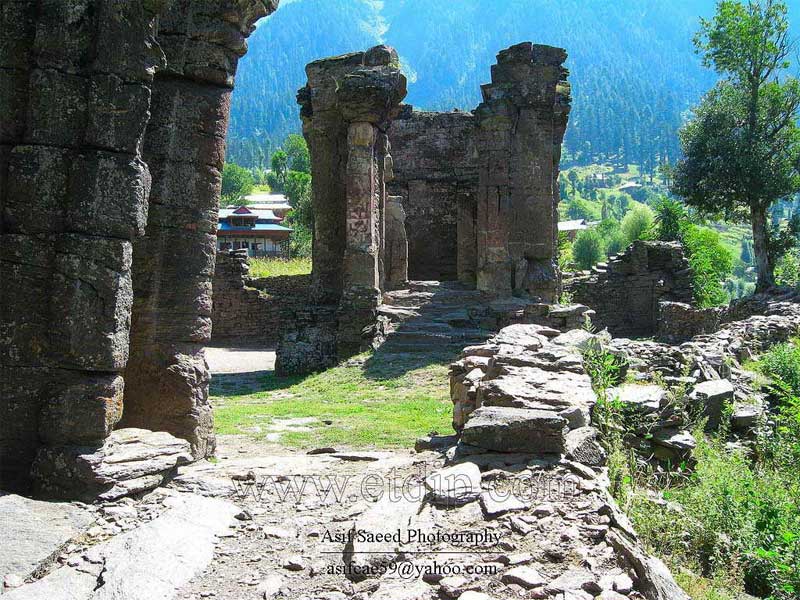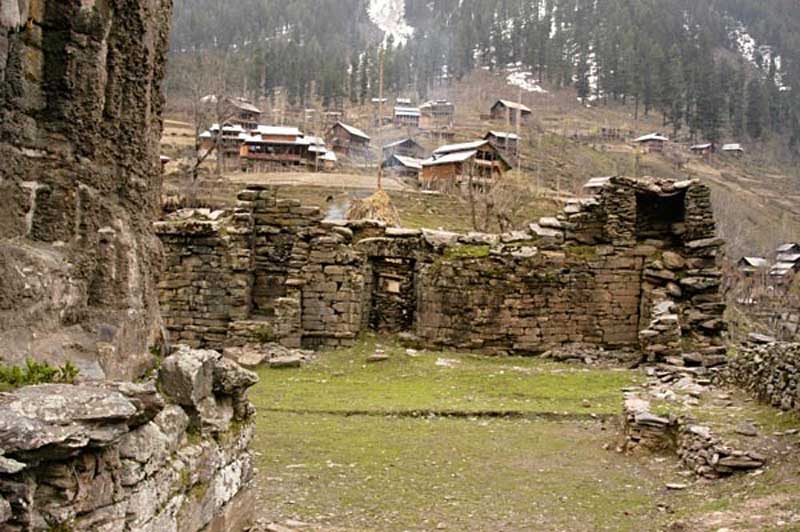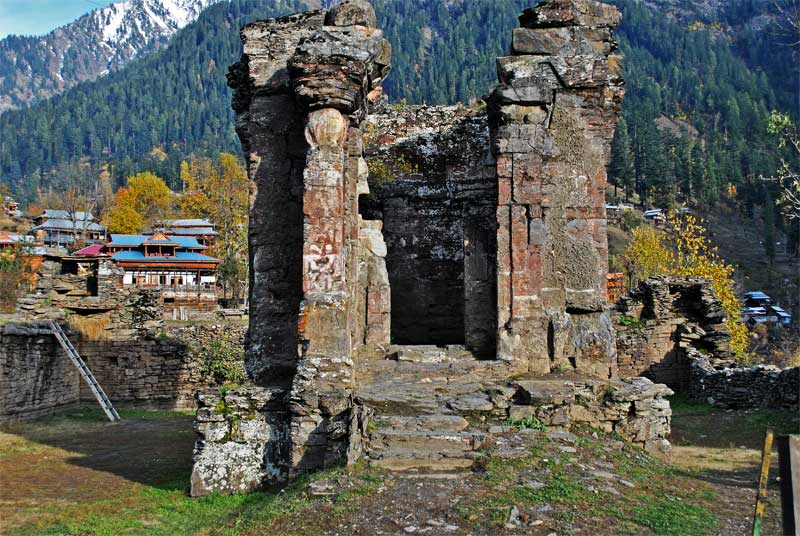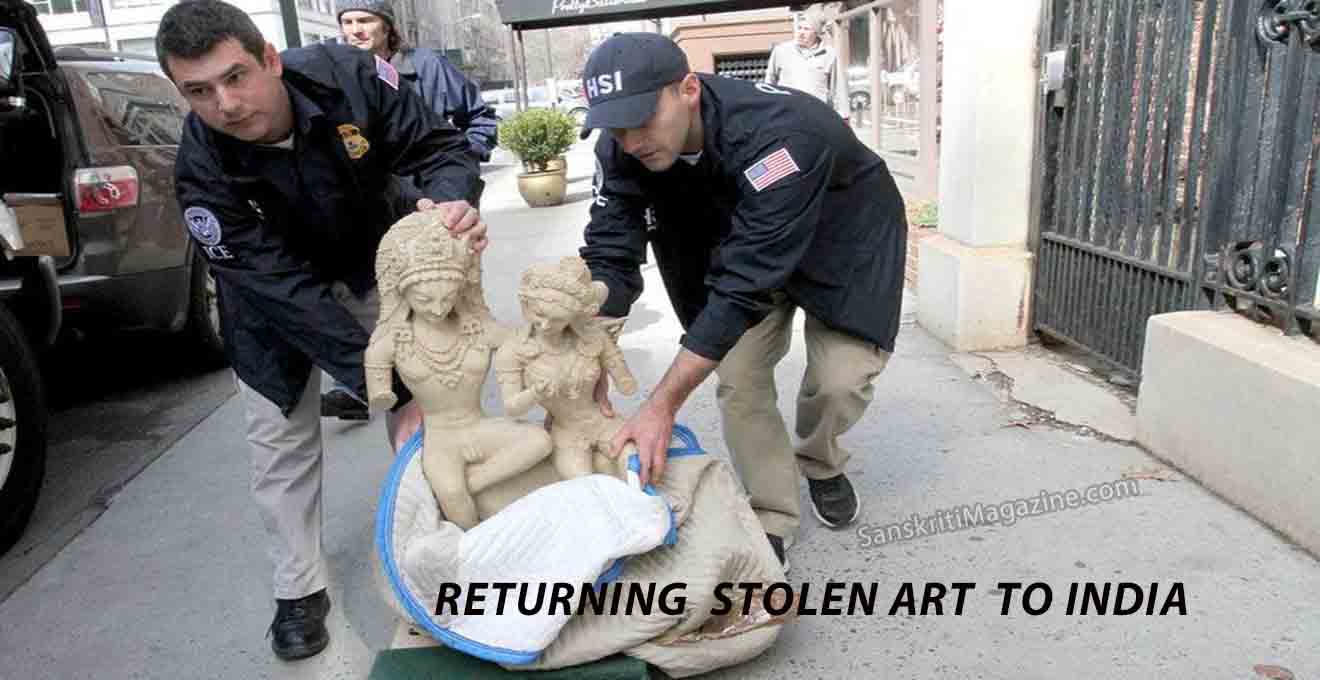Prior to independence, Hindu Pandits were settled in great numbers, in the Northern areas of Kashmir. Sharadi is a small village in Northern parts of Kashmir, which was famous for an ancient temple of Goddess Sharada. A Kashmiri Pandit family headed by Thusu Ladarwani was settled in this village. This Thusu family was compelled to migrate to Srinagar from Pakistan occupied Kashmir (POK) and again due to the terrorists and their activities, had forcibly to shift to Jammu and stay in a transit camp there.
At present, Shri Shambhunathji Thusu from this family is ninety four year old and possesses an exceptionally remarkable memory. He is well versed in Urdu, and Kashmiri language . Shri Shambhunathji provided me a map in Urdu prepared by him, giving details of the “Sharda Temple”. He has successfully retained many memories, about the “Sharda Temple” right from 1920 A.D. Shri. Shambhunathji reiterated that there was no idol of the Goddess Sharda in the temple, but there was only a stone plinth, measuring six feet long, seven feet wide and one and half feet high. “Just outside the temple, not very far, was a Shivaling. ( i.e . symbolic idol of Lord Shiva). The devotees worshipped at both the places.
Shri. Shambhunathji was born and brought up in Shardi and he spent his prime youth there only. His family owned a business there. He aptly recollects the fair held at Shardi in the month of Bhadrapada (the sixth month according to Hindu Calendar) on the eighth day of Shukla Paksha i.e. a fortnight of rising moon.
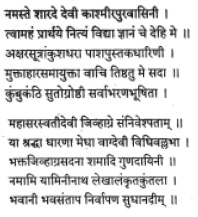
He makes a mention of the briefings by a scholar in History from “Shardi”, about the assistance rendered, by a Gaud King to the “Sharda Temple Complex”. The village Shardi is situated at a distance of 130 Kilometers from Srinagar and 140 k.m.s. from Muzaffarabad. This place, presently, has the following postal address in Pak occupied Kashmir. (POK).
Village Shardi, Tehsil Atta Mukam, District Muzafferabad
Since ancient times, the village Shardi was renowned for the following two things:
- temple of Goddess Sharda, and
- Sharda Peetham (Centre for Advanced studies)
Prior to the partition, a fair was held at village Shardi in the month of Bhadrapada and on the eighth day of the Shukla Paksha, and devotees from all over India, flocked the place in thousands, for receiving the blessings of the Mother Sharada deity. There is a place called “Tikkar” at a distance of one and half kilometers from Kupwara, in Kashmir. From here, there is a short cut for going to Shardi which measures 40 k.m. Many Pilgrims treaded this path only.
Prior to the partition of India, many Kashmiri Pandit families were settled in “Shardi”. Those professing as priests and traders had their shops and establishments in the near vicinity of the Sharda Teerath. Besides, many saints, ascetics and their associates/disciples and their servants also lived there.
Shri. Pradeep Kaul, from Srinagar, informed that every scribe offered his writings to Goddess Sharda, for obtaining her blessings. The following alleged legend in this regard runs as follows. The Kashmiri Scribes, kept their Bhurjapatra manuscript covered in a platter overnight, in front of Goddess Sharda, for obtaining her blessings. If the pages of writings remained undisturbed, it was taken for granted that the works had the blessings of the Goddess. If, however, the pages of the works were found sifted, the works were considered as disapproved by the Goddess.
Presently , the Sharda Temple lies within POK territory and one has to travel from Muzaffarbad to Thitwal – 80 K.M. from Thitwal to Karna-20 k.m., from Keran to Dudhe Niyal – 24 km, and from Dudhaniyal to Shardi- 16 K.M., to reach Shardi.
Prior to 1947, some travellers went to “Udi” from Barahmulla, and then from “Udi” to Shardi, via Muzaffarabad. In Shardi, the Sharda temple is on the right bank of river “Krishnaganga”. At this spot, there is a confluence between river Madhumati and river Krishnaganga. In Sanskrit, the word Sharda denotes both Goddess “Saraswati”, and Goddess “Durga”. An old styled, stringed musical Instrument called “Veena” is also addressed as “Sharda”. The Kashmiri Pandits, rever this Goddess Sharda as a symbol of strength. The brief history of “Sharda” in Kashmir is as follows.
“Kashyapmir” aka Kashmir means the Land of “Kashyap: Rishi the ascetic. Kashmir was a home of erudites and scholars. Here was an University of the extremely learned Pandits and philosphers in all branches of knowledge. The epic, Mahabharata, refers to Kashmir as “Kashmir Mandal”. Ancient History of India describes that there was a temple of “Goddess Sharda” in Kashmir also. There was a centre for providing education, Sharada Peetha had four doors facing four direction. The southern door was always closed and no one from South ever entered from this door. “Shankaracharya” in 8th cent A.D. opened this door and entered the Centre . He defeated all the scholars there and won the highest hierarchial position of Acharya. An ancient volume “Shakti Sangam Tantra” has a stray reference to “Sharda complex”. The volume describes Kashmir as a Land from Sharda Complex to “Saffron mountain ” Keshara Parbat extending upto 50 yojana.
At present, in POK, the valley of river Krishnaganga lies at a distance of 125 k.m. from Muzaffarabad towards North. It is now being addressed as “Neelam Valley” by Pakistani authorities.
The village “Shardi” lies in between Gurej and Karna: the two places in Neelam valley. At Shardi, wreckaged remains of the temple of Goddess Sharda can be seen. One can reach Shardi within 4 hours from Muzaffarbad. The following are the lines from the verse of “Goddess Sharda” (residing in Kashmir) in praise of her
Prior to Division of Kashmir in last century Mr. Bamzai, a Kashmiri Pandit, has very aptly described the Sharda Temple had the main girdle of 22 feet dia. It had an entrance door in the west. The other entrances had arches over them, and these arches were 20 feet in height .The main entrance had foot steps. On both sides of the porch, there were two square shaped pillars, 16 feet high and 2’6″ x 2’6″ in sectional size. Carved out of a solid stone Block. The construction inside the temple was very plain and unadorned . The temple was situated on a hillock, on the right’ bank of river Madhumati”. The rectangular sanctum had 63 foot steps, each 9′ wide. The name and fame of this Sharda Teerath was well spread throughout ancient India.
Kalhan, the famous Historian, who wrote “Rajtarangini has given a reference to “Lalitaditya” of the eighth’s century. He says, disciples of the Gaud King had come all the way from Bengal to Kashmir to pay a visit to this Sharda Mandir.
Alberuni, the famous traveller of the 10th century has made a mention of this “Sharada Mandir”. He narrates “After traversing the interior portion of the valley of Kashmir, one reaches the Bolair Mountain, which is mid way between “Ladakh” and “Gilgit’. Many pilgrims come here for receiving the blessings of Goddess Sharda”. Albe-runi further states that this “Sharda Teerath is equally famous like Som Nath of Gujarat, the Vishnu Temple of Thaneshwar, and the Sun-Temple of Multan.
“Bilhan” Pandit the famous author of the Later half of the 11th Century has also made a mention of the :Sharada Teerath”. Though settled in South India over a long period, “Bilhan” has dedicated all his Literary works to Goddess “Sharda”.
Between the period 1088 A.D. and 1172 A.D., an erudite, Shri Hemchandra had completed his“Prabhav Karta” a voluminous treatise. Under the auspices and patronage of King “Jay Singh” of Gujarat, he was required to compile a volume on “Grammar”. So, king Jay Singh deputed his representative to Kashmir, and made available to Shri Hemchandra a manuscript of the subject of grammar, from the Library of Sharda Teerth. This enabled Shri. Hemchandra, to complete his treatise called “Hemkandra” (Siddha Hemkandra) . This amply proves, how the name and fame of the library of “Sharda Teerth” was well-known in ancient India and as to, how abounding was the Library of “Sharda Peeth”.
Historian Jon Raja has made a reference, as to, how Sultan of Kashmir Zain-ul-Abidin visited this place in 1422 A.D.
Abul Fazal has also made a reference to this place. The stone crafted Sharda Mandir, he adds, a beautiful temple at that-is situated on the bank of river Madhumti (Krishna Ganga). Gold was often found in the river basin here. A fair is held here, on the eighth day of every month of the (Shukla Paksha) fortnight of the rising moon. After the Mughals, the Dogra regime assumed power in Kashmir and the then Collector of Muzaffarabad, Col. Gundu repaired the temple and provided a new ceiling made of wood. He got fixed an annuity for the priest of the temple, under the orders of Maharaja Gulab Singh of Kashmir.
The Northeast province of our vast country India is Kashmir. Kashmir has its own style of temple Architecture. This style was developed, during the reign of King Lalitaditya (724 A.D.) and in 9th Century reached its Zenith, during the regime of Avantiverman. There are a few ancient temples in Kashmir. Among these, the Rudrash temple at Ludo, the sun-temple at “Martand” and the “Shankaracharya Temple at Srinagar are conspicuously famous. Generally, a temple in Kashmir has two parts, a square sanctum and a porch in front of it. These structures have centres and subcentres of Learning associated with them.
Experts opine that the pillars and columns of Kashmiri temples compare favourably with those of Derrik style. There is an expansive courtyard around the temple. This ancient Sharda Mandir is in (P.O.K.) today and has nurtured all the Salient features of Kashmiri style of Architecture.
Yograj Razdan and Mr. Ratan Kaul made available this rare photograph of Sharda Mandir from Sharadi. It is at their instance, it was available to me.
Kashmir, in ancient days, was a centre for education, pursuit of knowledge and studies of various sciences. That is exactly why, Kashmir is also called Land of Goddess Sharda, City of Goddess Sharda and Sharda Peetham (University).
The famous Chinese traveller, Hue-en-tsang visited Kashmir in the year 632 A.D. and lived there for almost two years. His notings assert that at Shardi, there are Pandits who are exceptionally brilliant, endowed with perspicacious wits and acumen and are genius in the real sense of the term. There is a narrative, regarding Goddess Sharda in Hindu Scriptures. When Pandits refuse to perform the sacred thread ceremony of “Shandilya” the son of ascetic “Vashishta”, he (Shandilya) under instructions of his father, went to Kashmir, to offer his services to Goddess Sharda. He bathed in the water tank near Sharda temple and got his body, transformed into radiant gold, afterwards, he, by the grace of Goddess Sharda obtained accomplishment and became famous as Shandilya Rishi the ascetic.
The Sharda Shastranam Stotra is a canticle depicting Goddess Sharda as follows:
Goddess Sharda is “Sheeladevi” (A Goddess in stone) she sits on a stone seat and has a pleasantly smiling face. Her form and appearance resemble those of Goddess Parvati (Wife of Lord Shiva). She holds a Sword in one hand. Her eyes are glowing and radiant like the Sun, the moon and the god fire, she is the Supreme controller of all the three “Lokas” (According to Hindu Mythology, there are three lokas i.e. worlds swarga (the heaven) Mrutya (the Earth) and Patal (the under world). She has six arms and sports the sacred thread of Yagyopavit Shandilys, the ascetic. Her devotees are blessed with the eternal light from the outer world.
The members of the Gujar and Pahadi Communities, residing in the nearby area of the “Shardi” village had an abiding and unalienable faith in the sheeladevi shakti peeth (a source of power). They offered cow’s milk and cereals and other agricultural produce to Goddess Sharda. In the recent times, Swami Nandlalji a famous Yogi (a hermit) from Kashmir had his hermitage near the Sharda temple, and his disciples were both’ Hindus
This is how the imposing and magnificent history of Goddess Sharda for a few centuries in the post goes. The following lines from a Sanskrit canticle are enough and sufficient to stress the importance of the history of Goddess Sharda.

~ Sanjay Godbole

